During the EDCI 339 course, I had a new understanding of the ORE open education method, although in our life, such education method is not yet very popular. From the establishment of the EDCI339 course, its significance is of great significance. For the first time, I realized the convenience of open education for me to learn knowledge. We can share our opinions on the same article through online Blog sharing. We also completed an interesting project online. Although there were some errors in the communication, everyone worked hard to complete the part they were responsible for.
Digital Equity & Perspective Pod Project
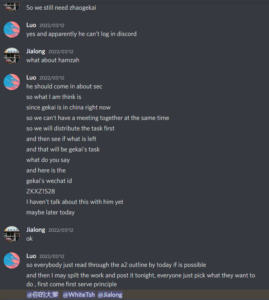
From the beginning, we pushed everyone to focus on our Pod Project.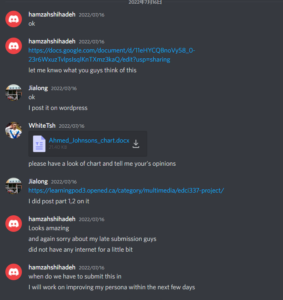
Since JIAHUI Lyn and I are in charge of a part, we make a unified reply.

Here’s some discussion of our Pod project after we’re done.
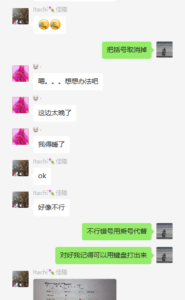
For some reason, there was a problem with our form, so we communicated in real time in the WeChat group.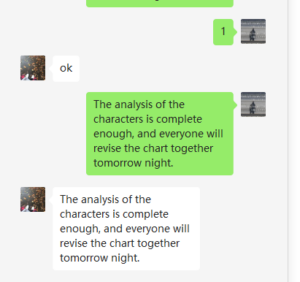
4 Topic parts
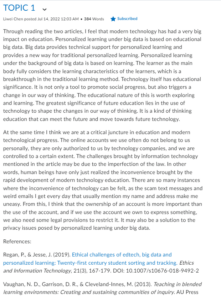
This is the first topic published in brightspace. After editing, I will post it on WordPress later. In the process of modification, I have read other people’s topics.
Topic 1’s article is a discussion of the importance of privacy.The challenges brought by information technology mentioned in the article may be due to the imperfection of the law. In other words, human beings have only just realized the inconvenience brought by the rapid development of modern technology education. There are so many instances where the inconvenience of technology can be felt, as the scam text messages and weird emails I get every day that usually mention my name and address make me uneasy. From this, I think that the ownership of an account is more important than the use of the account, and if we use the account we own to express something, we also need some legal provisions to restrict it.
TOPIC 2: TEACHING ONLINE
I understand that efficient management of open educational resources can develop intelligent and personalized smart classrooms.
The author believes that allowing users to use the resources of the media resource management platform flexibly and to carry out teaching activities is the ultimate goal, and the way to make it all easier is to use integrated digital resources, just like edci 339, teachers will plan and integrate The resources owned by the school, and then establish a unified “resource center” to allow each student to complete each homework according to the plan and guidance. All of them reflect efficient and high-quality online teaching.
The writing of Topic 2 is quite difficult. I had a discussion on Topic 2 with my roommate Jiahui Lyn, and I also shared my thesis with him.
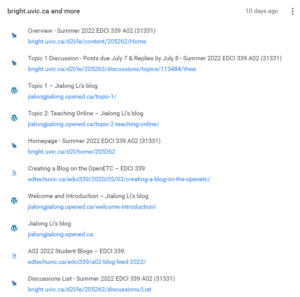
Topic 3
Open pedagogy 1 which is written by ROBIN DEROSA and RAJIV JHANGIANI introduces the philosophical foundation, investments, and its utility of open pedagogy, as well as the specific approaches that teachers and students adopt to implement open pedagogy. Open pedagogy refers to a set of teaching practices that can only be carried out under the background of free access to open educational resources. The purpose of open education is to build a platform where every user can learn, discuss, teach, etc., to inform educational practice and structure. Open Educational Resources (OER) are teaching and learning materials that you can use and reuse for free without permission. 5R which is the characteristic of OER, is the basic basis for sharing open content which can be reused, retained, redistributed, revised, and remixed by anyone.
This is my browsing record of other classmates’ articles when I modified TOPIC 3.
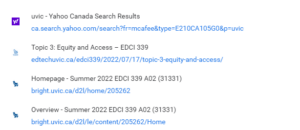
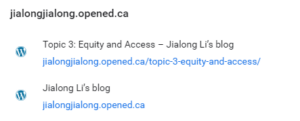
Topic 4
The pedagogy of OER refers to a set of teaching and learning practices used in the context of the 5R authority,the author explained the 5R-(retain, reuse, revise, remix and redistribute) in detail, and the 5R is what interests me the most because starting from my elementary school, it is important to find a learning path that suits me. The new learning approach makes learning more fun and efficient, and it is also improves academic performance and stimulates the creativity of each student, but most of the learning methods I have been exposed to are always related to non-stop learning books, which do not have the Stimulate students’ creativity, but for the continuous repetition of learning content. The author explains the meaning of the ORE system in the next the 4 metrics. The 4 metrics can be said to be the four steps of sharing results, so that successful learning results can gain the value they deserve and stimulate students’ creative ability again.

This is the link I posted in discord. Since every time we complete a topic, we share the link.
Reference
Wiley, D. & Hilton, J. (2018). Defining OER-enabled Pedagogy. International Review of Research in Open and Distance Learning, 19(4)
Wiley, D. & Hilton, J. (2018). Defining OER-enabled Pedagogy. International Review of Research in Open and Distance Learning, 19(4)
Major, C. H. (2015). Teaching Online – A Guide to Theory, Research, and Practice. Retrieved from http://ebookcentral.proquest.com/lib/uvic/detail.action?docID=3318874 (pp. 76-108)
Regan, P., & Jesse, J. (2019). Ethical challenges of edtech, big data and personalized learning: Twenty-first century student sorting and tracking. Ethics and Information Technology, 21(3), 167-179. DOI: 10.1007/s10676-018-9492-2
Vaughan, N. D., Garrison, D. R., & Cleveland-Innes, M. (2013). Teaching in blended learning environments: Creating and sustaining communities of inquiry. AU Press